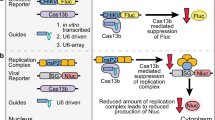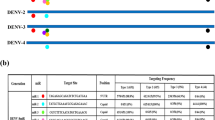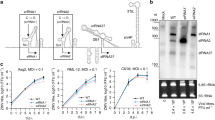Abstract
Dengue virus (DENV) is an arbovirus transmitted to humans by Aedes mosquitoes1. In the insect vector, the small interfering RNA (siRNA) pathway is an important antiviral mechanism against DENV2,3,4,5. However, it remains unclear when and where the siRNA pathway acts during the virus cycle. Here, we show that the siRNA pathway fails to efficiently silence DENV in the midgut of Aedes aegypti although it is essential to restrict systemic replication. Accumulation of DENV-derived siRNAs in the midgut reveals that impaired silencing results from a defect downstream of small RNA biogenesis. Notably, silencing triggered by endogenous and exogenous dsRNAs remained effective in the midgut where known components of the siRNA pathway, including the double-stranded RNA (dsRNA)-binding proteins Loquacious and r2d2, had normal expression levels. We identified an Aedes-specific paralogue of loquacious and r2d2, hereafter named loqs2, which is not expressed in the midgut. Loqs2 interacts with Loquacious and r2d2 and is required to control systemic replication of DENV and also Zika virus. Furthermore, ectopic expression of Loqs2 in the midgut of transgenic mosquitoes is sufficient to restrict DENV replication and dissemination. Together, our data reveal a mechanism of tissue-specific regulation of the mosquito siRNA pathway controlled by Loqs2.
This is a preview of subscription content, access via your institution
Access options
Access Nature and 54 other Nature Portfolio journals
Get Nature+, our best-value online-access subscription
$29.99 / 30 days
cancel any time
Subscribe to this journal
Receive 12 digital issues and online access to articles
$119.00 per year
only $9.92 per issue
Buy this article
- Purchase on Springer Link
- Instant access to full article PDF
Prices may be subject to local taxes which are calculated during checkout




Similar content being viewed by others
Data availability
Small RNA libraries from this study have been deposited in the Sequence Read Archive (SRA) at NCBI. Other publicly available RNA–seq data sets were obtained from SRA. Accession numbers and references are provided in Supplementary Table 4.
References
Guzman, M. G., Gubler, D. J., Izquierdo, A., Martinez, E. & Halstead, S. B. Dengue infection. Nat. Rev. Dis. Primers 2, 16055 (2016).
Sanchez-Vargas, I. et al. Dengue virus type 2 infections of Aedes aegypti are modulated by the mosquito’s RNA interference pathway. PLoS Pathog. 5, e1000299 (2009).
Khoo, C. C. H., Piper, J., Sanchez-Vargas, I., Olson, K. E. & Franz, A. W. E. The RNA interference pathway affects midgut infection- and escape barriers for Sindbis virus in Aedes aegypti. BMC. Microbiol. 10, 130 (2010).
Franz, A. W. et al. Engineering RNA interference-based resistance to dengue virus type 2 in genetically modified Aedes aegypti. Proc. Natl Acad. Sci. USA 103, 4198–4203 (2006).
Campbell, C. L. et al. Aedes aegypti uses RNA interference in defense against Sindbis virus infection. BMC Microbiol. 8, 47 (2008).
Hess, A. M. et al. Small RNA profiling of dengue virus–mosquito interactions implicates the piwi RNA pathway in anti-viral defense. BMC Microbiol. 11, 45 (2011).
Miesen, P., Ivens, A., Buck, A. H. & van Rij, R. P. Small RNA profiling in dengue virus 2-infected Aedes mosquito cells reveals viral piRNAs and novel host miRNAs. PLoS Negl. Trop. Dis. 10, e0004452 (2016).
Villalon, J. M., Ghosh, A. & Jacobs-Lorena, M. The peritrophic matrix limits the rate of digestion in adult Anopheles stephensi and Aedes aegypti mosquitoes. J. Insect. Physiol. 49, 891–895 (2003).
Aguiar, E. R. G. R., Olmo, R. P. & Marques, J. T. Virus-derived small RNAs: molecular footprints of host–pathogen interactions. Wiley Interdiscip. Rev. RNA 7, 824–837 (2016).
Richardson, J., Molina-Cruz, A., Salazar, M. I. & Black, W. Quantitative analysis of dengue-2 virus RNA during the extrinsic incubation period in individual Aedes aegypti. Am. J. Trop. Med. Hyg. 74, 132–141 (2006).
Salazar, M. I., Richardson, J. H., Sánchez-Vargas, I., Olson, K. E. & Beaty, B. J. Dengue virus type 2: replication and tropisms in orally infected Aedes aegypti mosquitoes. BMC Microbiol. 7, 9 (2007).
Carthew, R. W. & Sontheimer, E. J. Origins and mechanisms of miRNAs and siRNAs. Cell 136, 642–655 (2009).
Ghildiyal, M. et al. Endogenous siRNAs derived from transposons and mRNAs in Drosophila somatic cells. Science 320, 1077–1081 (2008).
Marques, J. T. et al. Functional specialization of the small interfering RNA pathway in response to virus infection. PLoS Pathog. 9, e1003579 (2013).
Ashe, A. et al. A deletion polymorphism in the Caenorhabditis elegans RIG-I homolog disables viral RNA dicing and antiviral immunity. eLife 2, e00994 (2013).
Hartig, J. V. & Förstemann, K. Loqs-PD and R2D2 define independent pathways for RISC generation in Drosophila. Nucleic Acids Res. 39, 3836–3851 (2011).
Marques, J. T. et al. Loqs and R2D2 act sequentially in the siRNA pathway in Drosophila. Nat. Struct. Mol. Biol. 17, 24–30 (2010).
Tabara, H., Yigit, E., Siomi, H. & Mello, C. C. The dsRNA binding protein RDE-4 interacts with RDE-1, DCR-1, and a DExH-box helicase to direct RNAi in C. elegans. Cell 109, 861–871 (2002).
Parrish, S. & Fire, A. Distinct roles for RDE-1 and RDE-4 during RNA interference in Caenorhabditis elegans. RNA 7, 1397–1402 (2001).
Hartig, J. V., Esslinger, S., Böttcher, R., Saito, K. & Förstemann, K. Endo-siRNAs depend on a new isoform of loquacious and target artificially introduced, high-copy sequences. EMBO J. 28, 2932–2944 (2009).
Haac, M. E., Anderson, M. A., Eggleston, H., Myles, K. M. & Adelman, Z. N. The hub protein loquacious connects the microRNA and short interfering RNA pathways in mosquitoes. Nucleic Acids Res. 43, 3688–3700 (2015).
Edwards, M. J. et al. Characterization of a carboxypeptidase A gene from the mosquito, Aedes aegypti. Insect Mol. Biol. 9, 33–38 (2000).
Carissimo, G. et al. Antiviral immunity of Anopheles gambiae is highly compartmentalized, with distinct roles for RNA interference and gut microbiota. Proc. Natl Acad. Sci. USA 112, E176–E185 (2015).
Sarkies, P. et al. Ancient and novel small RNA pathways compensate for the loss of piRNAs in multiple independent nematode lineages. PLoS Biol. 13, e1002061 (2015).
Maillard, P. V. et al. Antiviral RNA interference in mammalian cells. Science 342, 235–238 (2013).
Li, Y., Lu, J., Han, Y., Fan, X. & Ding, S. W. RNA interference functions as an antiviral immunity mechanism in mammals. Science 342, 231–234 (2013).
Pereira, T. N., Rocha, M. N., Sucupira, P. H. F., Carvalho, F. D. & Moreira, L. A. Wolbachia significantly impacts the vector competence of Aedes aegypti for Mayaro virus. Sci. Rep. 8, 6889 (2018).
Donald, C. L. et al. Full genome sequence and sfRNA interferon antagonist activity of Zika virus from Recife, Brazil. PLoS Negl. Trop. Dis. 10, e0005048 (2016).
Sedda, L. et al. The spatial and temporal scales of local dengue virus transmission in natural settings: a retrospective analysis. Parasit. Vectors 11, 79 (2018).
Barletta, A. B. et al. Microbiota activates IMD pathway and limits Sindbis infection in Aedes aegypti. Parasit. Vectors 10, 103 (2017).
Tan, G. K. et al. A non mouse-adapted dengue virus strain as a new model of severe dengue infection in AG129 mice. PLoS Negl. Trop. Dis. 4, e672 (2010).
Lanford, R. E., Sureau, C., Jacob, J. R., White, R. & Fuerst, T. R. Demonstration of in vitro infection of chimpanzee hepatocytes with hepatitis C virus using strand-specific RT/PCR. Virology 202, 606–614 (1994).
Pfeffer, S. et al. Identification of virus-encoded microRNAs. Science 304, 734–736 (2004).
Jayaprakash, A. D., Jabado, O., Brown, B. D. & Sachidanandam, R. Identification and remediation of biases in the activity of RNA ligases in small-RNA deep sequencing. Nucleic Acids Res. 39, e141 (2011).
Martin, M. Cutadapt removes adapter sequences from high-throughput sequencing reads. EMBnet J. 17, 10–12 (2011).
Langmead, B., Trapnell, C., Pop, M. & Salzberg, S. L. Ultrafast and memory-efficient alignment of short DNA sequences to the human genome. Genome Biol. 10, R25 (2009).
Dobin, A. et al. STAR: ultrafast universal RNA–seq aligner. Bioinformatics 29, 15–21 (2013).
Li, B. & Dewey, C. N. RSEM: accurate transcript quantification from RNA–seq data with or without a reference genome. BMC Bioinformatics 12, 323 (2011).
Robinson, M. D., McCarthy, D. J. & Smyth, G. K. edgeR: a Bioconductor package for differential expression analysis of digital gene expression data. Bioinformatics 26, 139–140 (2010).
Sievers, F. et al. Fast, scalable generation of high-quality protein multiple sequence alignments using Clustal Omega. Mol. Syst. Biol. 7, 539 (2011).
Engler, C. & Marillonnet, S. Combinatorial DNA assembly using Golden Gate cloning. Methods Mol. Biol. 1073, 141–156 (2013).
Geissler, R. et al. Transcriptional activators of human genes with programmable DNA-specificity. PLoS ONE 6, e19509 (2011).
Volohonsky, G. et al. Tools for Anopheles gambiae transgenesis. G3 (Bethesda) 5, 1151–1163 (2015).
Jasinskiene, N., Juhn, J. & James, A. A. Microinjection of A. aegypti embryos to obtain transgenic mosquitoes. J. Vis. Exp. 2007, 219 (2007).
Morris, A. C., Eggleston, P. & Crampton, J. M. Genetic transformation of the mosquito Aedes aegypti by micro-injection of DNA. Med. Vet. Entomol. 3, 1–7 (1989).
Stoetzel, C. et al. A mutation in VPS15 (PIK3R4) causes a ciliopathy and affects IFT20 release from the cis-Golgi. Nat. Commun. 7, 13586 (2016).
Chicher, J. et al. Purification of mRNA-programmed translation initiation complexes suitable for mass spectrometry analysis. Proteomics 15, 2417–2425 (2015).
Perkins, D. N., Pappin, D. J. C., Creasy, D. M. & Cottrell, J. S. Probability-based protein identification by searching sequence databases using mass spectrometry data. Electrophoresis 20, 3551–3567 (1999).
Acknowledgements
The authors thank C.N.D. dos Santos for providing 4G2 monoclonal antibodies. This work was supported with funding from Conselho Nacional de Desenvolvimento Científico e Tecnológico (CNPq), Coordenação de Aperfeiçoamento de Pessoal de Nível Superior (CAPES) and Fundação de Amparo a Pesquisa do Estado de Minas Gerais (FAPEMIG) to J.T.M., Agence Nationale de la Recherche (ANR-11-ASV3-002) and Investissement d’Avenir Programs (ANR-10-LABX-36; ANR-11-EQPX-0022) to J.T.M and J.-L.I., and Inserm, CNRS and the University of Strasbourg to E.M. and J.-L.I. Mass spectrometry instrumentation was funded by the University of Strasbourg, IdEx Equipement mi-lourd 2015 to L.K. and P.H. National and/or international fellowships from CAPES were granted to R.P.O., T.C.I.-T., A.G.A.F., E.R.G.R.A., K.P.R.S., K.P.O. and C.D.O., and national and/or international fellowships from CNPq were granted to I.J.S.F., L.A.M. and J.T.M.
Author information
Authors and Affiliations
Contributions
R.P.O. and J.T.M. designed the project. R.P.O., A.G.A.F., T.C.I.-T., I.J.S.F., K.P.R.S., K.P.O., P.H., E.G.A., Y.M.T, M.N.R., T.H.J.F.L., S.C.G.A., J.N.A. and S.P. performed experiments. R.P.O., E.R.G.R.A. and L.K. performed bioinformatics analysis. C.D.O., F.D.C., L.A.M and E.M. contributed to mosquito experiments. R.P.O., E.R.G.R.A., J.-L.I. and J.T.M. analysed the data. R.P.O., J.-L.I. and J.T.M. wrote the paper. All authors discussed the results and commented on the manuscript.
Corresponding author
Ethics declarations
Competing interests
The authors declare no competing interests.
Additional information
Publisher’s note: Springer Nature remains neutral with regard to jurisdictional claims in published maps and institutional affiliations.
Supplementary information
Supplementary Information
Supplementary Figures 1–4, Supplementary Tables 2–4.
Supplementary Table 1
Mass spectrometry analysis of Loqs2 interacting proteins.
Supplementary File 1
Plasmid sequence containing the cassette (attP loxP CP::3×FLAG-Loqs2-Sv40pA, PUb::mTurquoise2-Sv40pA loxP) flanked by piggyBac repeats.
Supplementary File 2
Plasmid sequence containing the cassette (attP loxP PUb::3×FLAG-eGFPSv40pA, OpIE2::Puromicin-Sv40pA loxP) flanked by piggyBac repeats.
Supplementary File 3
Plasmid sequence containing the cassette (attP loxP PUb::3×FLAG-Loqs2-Sv40pA, OpIE2::Puromicin-Sv40pA loxP) flanked by piggyBac repeats.
Rights and permissions
About this article
Cite this article
Olmo, R.P., Ferreira, A.G.A., Izidoro-Toledo, T.C. et al. Control of dengue virus in the midgut of Aedes aegypti by ectopic expression of the dsRNA-binding protein Loqs2. Nat Microbiol 3, 1385–1393 (2018). https://doi.org/10.1038/s41564-018-0268-6
Received:
Accepted:
Published:
Issue Date:
DOI: https://doi.org/10.1038/s41564-018-0268-6



